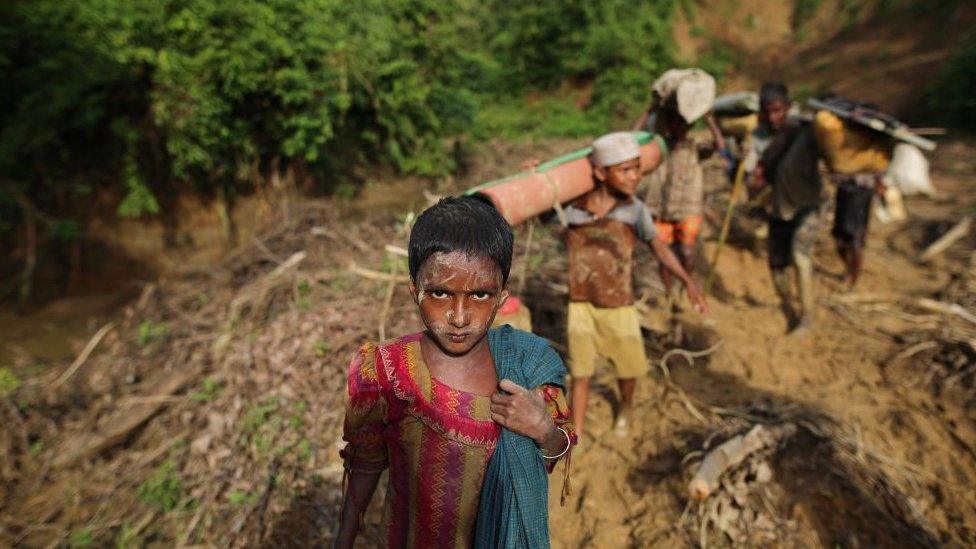Myanmar Rohingya: Aung San Suu Kyi cuts a haunted figure in court
- Published
Aung San Suu Kyi: "Our greatest challenge is to address the roots of distrust and fear, prejudice and hate"
The spectacle of Aung San Suu Kyi, a once-persecuted Nobel peace laureate now defending her country against allegations of genocide over its treatment of the Rohingya minority, has been one of bewildering irony.
In the years after she was released from house arrest in 2010, princes, presidents and prime ministers welcomed Aung San Suu Kyi with open arms into their own opulent homes.
The feel-good factor of rubbing shoulders with someone who had dedicated much of her adult life to the pursuit of democracy was irresistible.
Then, the grandeur of the Peace Palace in The Hague - a marble-floored monument to global harmony - would have been comfortable surroundings for Myanmar's Nobel Peace Prize winner. A native habitat, even.
But not now. There was no red carpet, welcoming committee or brass band.
Instead the light pouring through the stained glass of the Great Hall of Justice illuminated an often haunted-looking figure who had chosen to come and listen to descriptions of some of the most unimaginably gruesome acts. Acts said to have been committed in her country. On her watch.
Watch: Who are the Rohingya?
After two years on trial in the court of international public opinion, Aung San Suu Kyi was now trying to win over the 17 judges at the International Court of Justice (ICJ) - as she defended the same Myanmar military which had taken away her freedom for 15 years.
It was something she - and the rest of the world - surely never imagined would happen.
The cognitive dissonance of a faded beacon of universal human rights arguing against the horrific testimony of some of the 740,000 Rohingya Muslim refugees who had her fled her country pulsed through The Hague this week.
How did this peace icon end up at a genocide trial?
I realised that she was taking her seat in court 28 years to the day after she had accepted her Nobel prize, in absentia. It was a quirk of history that defined the slow-motion transformation of Aung San Suu Kyi's global standing.
I will long remember certain images from this remarkable week.
There were the Rohingya survivors who'd travelled from the crushing bleakness of Cox's Bazar - the largest refugee camp in the world - to be guests in the court.
Every morning, they arrived in the same type of sparkling executive transport as Ms Suu Kyi: afforded the same comfort as the leader of the country accused of trying to exterminate their people. For these three representatives of their stateless community, the scales of justice had finally levelled, if only for a few hours.
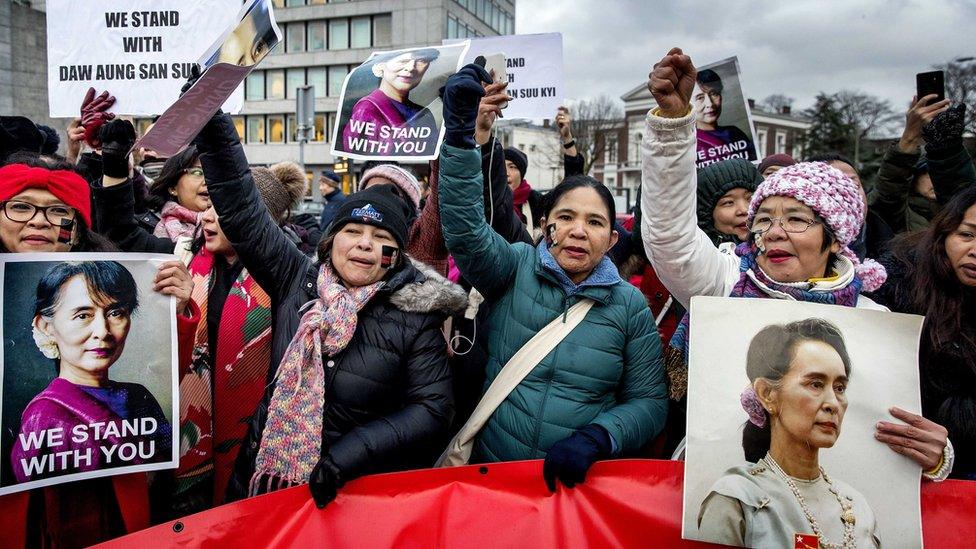
There have been demonstrations in support of Aung San Suu Kyi outside the court
Then there was the face of Aung San Suu Kyi, possibly hearing for the first time in such brutal detail the crimes alleged to have been perpetrated by the Burmese Army in their clearance operation in Rakhine state in August 2017.
Such was the interest in Aung San Suu Kyi's appearance, they had to open a second room to contain the international media. There were rueful shakes of the head, gentle intakes of breath as lawyers for The Gambia read out graphic accounts from Rohingya survivors: pregnant women beaten to death, mass rape, children thrown into fires.
We watched Ms Suu Kyi's face - seemingly frozen at times - on a large television as she listened to the allegations against her Myanmar.
Aung San Suu Kyi may have sat alongside her legal team and a small Burmese delegation but she often cut a lonely figure. She is a leader who has alienated herself from former friends in the West and taken refuge in the powerful embrace of China, which continues to provide invaluable economic support and political protection in the UN Security Council.
The Rohingya mark two years of exile
It is the certainty of a Chinese veto on any vote on Myanmar's alleged crimes that has blocked the most obvious path to justice for the Rohingya: a referral to the International Criminal Court (ICC).
I will remember the crowds outside court - both for and against Ms Suu Kyi. More than a hundred supporters had flown the 5,000 miles from Myanmar to wave banners and shout slogans supporting "Mother Suu".
I have no doubt the affection for her was genuine - this was no communist regime-style gathering where pure fear drives the chanting and nobody want to be first to stop applauding. In fact, they sang an old favourite which criticises the former military dictatorship - the apparatus of evil which truly instilled terror in people's hearts.
That said, there was an approved list of songs and a ban on waving flags of Ms Suu Kyi's National League for Democracy (NLD) party. Presumably, this was to avoid the impression the NLD was benefitting from her appearance in the Hague. But be in no doubt her defence of the nation will have given her a huge domestic boost ahead of next year's general election in Myanmar.
Jonathan Head visits the Hla Poe Kaung transit camp, which is built on the site of two demolished Rohingya villages
I saw three photographs this week which felt significant. The first was the image of 10 murdered Rohingya men in a grave in the village of Inn Din, shown to the court. This was the massacre exposed by Reuters reporters Kyaw Soe Oo and Wa Lone. The journalistic world rewarded them with a Pulitzer Prize; Myanmar handed them more than 500 days in prison. Aung San Suu Kyi's legal team suggested it was a gratuitous and tasteless picture to show.
When it was the Nobel Peace Prize winner's turn to put something on screen she chose a snap of a smiling crowd at a football match in Maungdaw township in Rakhine State. Buddhists and Muslims united, shoulder to shoulder. It felt a strange, naive and weak response to the Inn Din photo.
The third and final photograph was sent to me by a Burmese colleague in Yangon. I received it just as Aung San Suu Kyi was addressing the court for the final time. It showed a tank on the street.
Watch: Nick Beake gets a rare look at Myanmar's military parade
I froze. Was this a military coup? An attempt by the still-powerful generals to steal back the country while the democratically elected leader was defending their troops to the world? It turned out the tanks were apparently being transported to a new base but it caused hearts to race in a country whose transition to democracy is still precarious.
Aung San Suu Kyi's decision to come here ensured this would always become a massive spectacle and one which marked the end of any lingering hope in the West that she would distance herself from the army she doesn't control.
After two years of blistering international criticism for failing to use her moral authority to stand up for the Rohingya, she is now the permanent face of the legal defence of some of the worst abuses imaginable.
The generals, safe for now and far from the winter chill of The Hague, have watched a Nobel Peace Prize winner trying, in many people's eyes, to defend the indefensible. They wouldn't have it any other way.
- Published30 March 2018
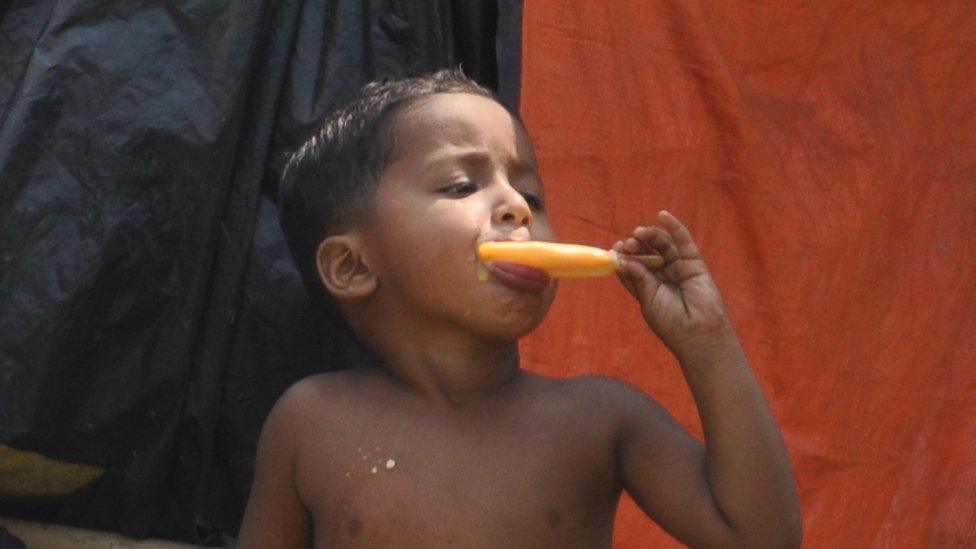
- Published12 September 2018
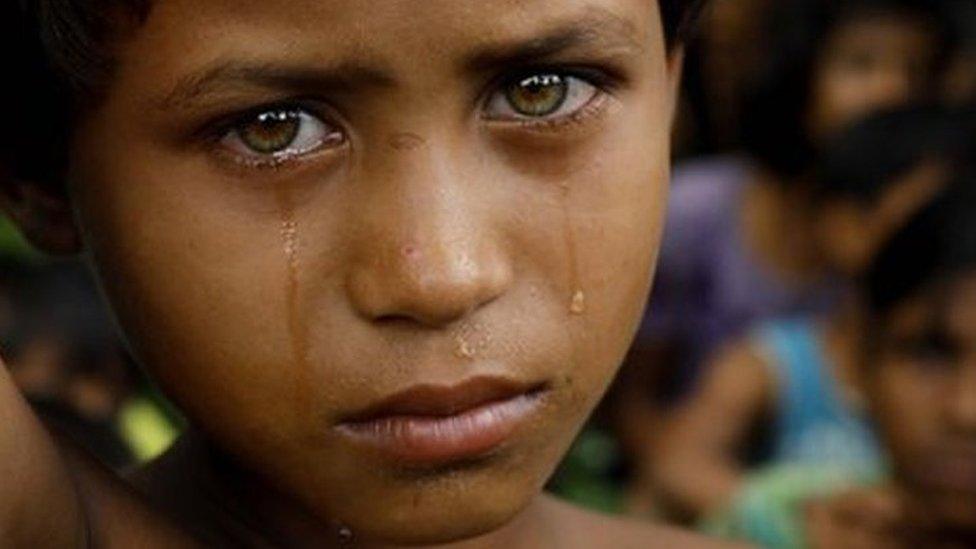
- Published23 January 2020

- Published12 December 2019
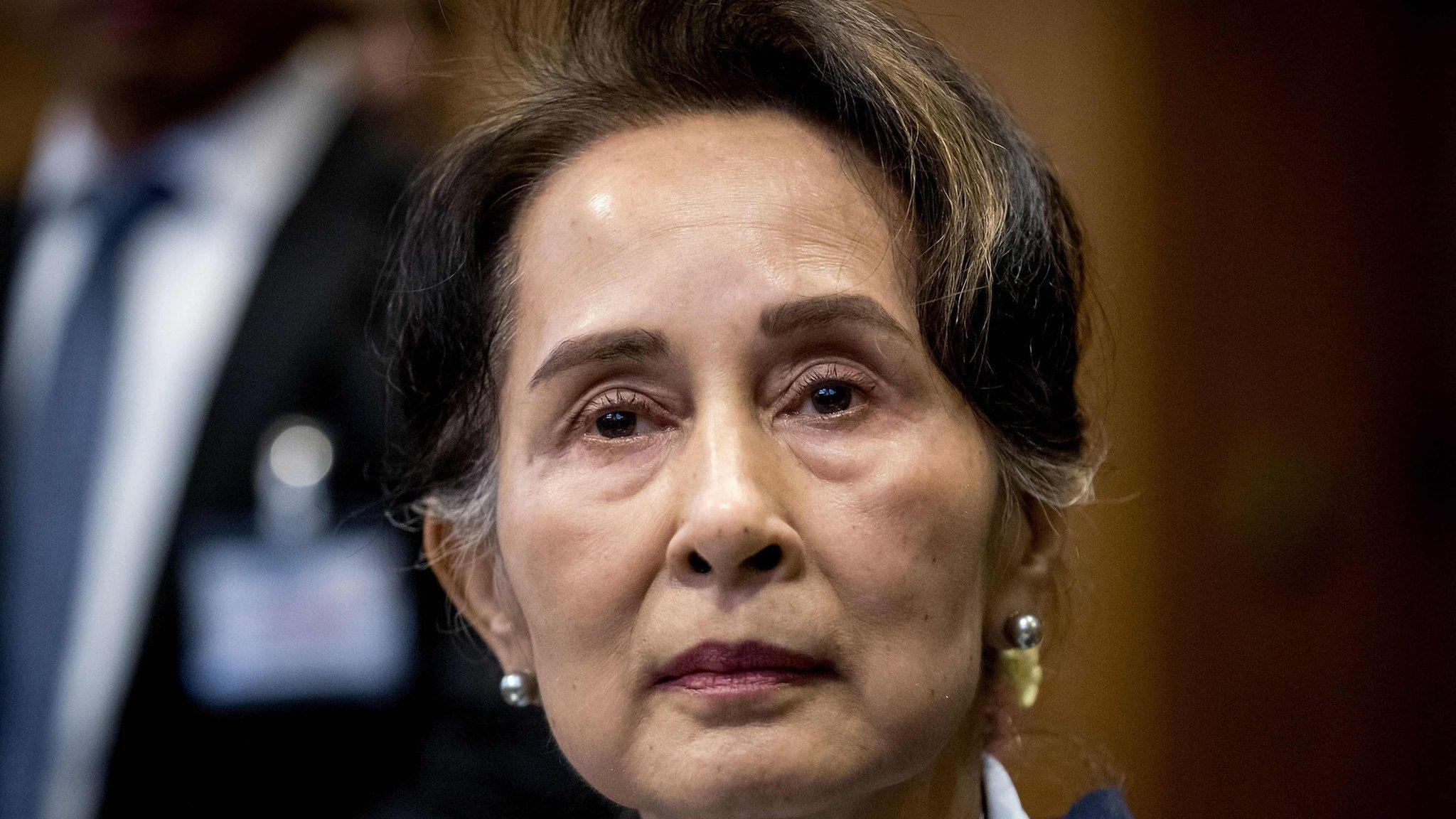
- Published28 December 2018
